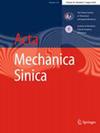Modulation of transformation strain based on crystal orientation effects in NiTi shape memory alloy
Abstract
Equiatomic NiTi shape memory alloys (SMAs) can exhibit multiple martensitic transformations from a parent phase, significantly influencing the advanced macroscopic properties of SMAs, such as the large deformation/strain ability. A comprehensive atomic-scale understanding of the selection rule of the martensite phase/variant and its impact on the macroscopic mechanical behavior of SMA could be helpful for the development of high-performance SMAs. This work studies the transformation pathway, preferred martensite variant and corresponding macroscopic behavior of single crystal and bicrystal NiTi SMAs based on molecular dynamics and theoretical analysis. It is found that the transformation strain of single crystal NiTi is significantly influenced by the crystal orientation-dependent transformation pathway and martensite variant. The selection rule is that the transformation pathway and preferred martensite variant, leading to maximum transformation strains for each orientation, are energetically preferred. It can be predicted theoretically and agrees well with the molecular dynamic simulations. In addition, the stress-strain response of bicrystal NiTi can be modulated by changing its transformation pathway based on the orientation effect. This work provides atomic insights into the orientation-dependent deformation ability of NiTi and could be helpful for the development of high-performance SMAs through orientation modulation.

 求助内容:
求助内容: 应助结果提醒方式:
应助结果提醒方式:


